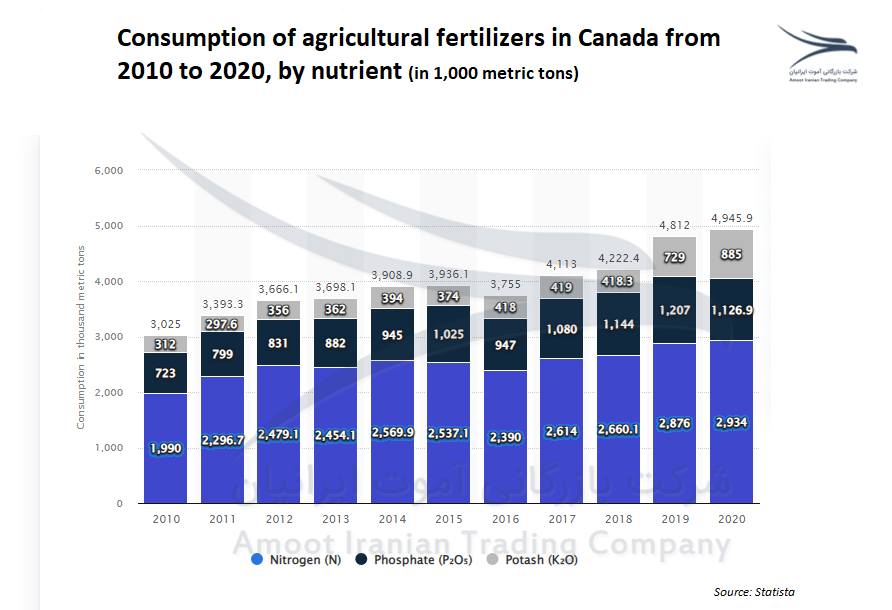.
Canada’s economy greatly benefits from the fertilizer industry, with over $23B yearly revenue and 76,000 job opportunities (Government of Canada)

.
How Big Is the Fertilizer Industry in Canada?
Does Canada have fertilizer plants? Does Canada make fertilizers?
The fertilizer industry is a vital component of Canada’s economy, generating an annual revenue of over $23 billion and providing employment opportunities for 76,000 people.
Canada also plays a significant role in the global fertilizer supply, producing 12% of the world’s fertilizer and exporting to more than 75 countries. The use of fertilizers is essential for farmers to meet the increasing demand for food to feed the growing global population.
.
What Is the Largest Fertilizer Company in Canada?
Nutrien is the largest fertilizer company in Canada.
.

.
Nutrien, a Canadian fertilizer company headquartered in Saskatoon, Saskatchewan, is the world’s largest producer of potash and the third-largest producer of nitrogen fertilizer.
The company has a vast retail network, with over 2,000 locations spread across North and South America, and Australia, and employs more than 23,500 people.
.

.
Canada Fertilizer Export
- As of December 2022, Canada’s fertilizer exports were worth C$1.15B, while imports were valued at C$354M, resulting in a favorable trade balance of C$796M.
- From December 2021 to December 2022, Canadian fertilizer exports increased by C$159M (16.1%) from C$990M to C$1.15B.
- In terms of fertilizer exports, Canada ranks third in the world in 2021.
- Canada fertilizer exports worth $6.93 billion in 2021.
- Fertilizers were the 18th most exported product from Canada in 2021.
- Canada was ranked as the 16th largest exporter of Nitrogenous Fertilizers globally in 2021, with an export value of $719M.
- With a total export value of $514k in Phosphatic Fertilizers, Canada was ranked as the 51st largest exporter of Phosphatic Fertilizers globally in 2021.
- Canada was ranked as the largest exporter of Potassic Fertilizers globally in 2021, with a total export value of $6.03B.
- With an export value of $41.1M in Animal or Vegetable Fertilizers, Canada was ranked as the 8th largest exporter of this type of fertilizer globally in 2021.
.
Top destinations for Canadian fertilizer exports:
- The United States: USD 3.8 billion
- Brazil: USD 1.07 billion
- Indonesia: USD 504 million
- China: USD 328 million
- Malaysia: USD 207 million
.
The fastest growing export markets for Canada Fertilizers between 2020 and 2021:
- United States
- Brazil
- Indonesia
.
Canada Fertilizer Import
- As of December 2022, Canada’s fertilizer imports were worth C$354M.
- As of 2021, Canada ranked as the 10th largest global importer of fertilizers in the world.
- From December 2021 to December 2022, Canadian imports decreased by C$-21.3M (-5.67%) from C$375M to C$354M.
- Canada fertilizer imports valued at $1.91B in 2021.
- Fertilizers were the 45th most imported product in Canada in 2021.
- The 15th position in the global ranking of Nitrogenous Fertilizers importers was held by Canada in 2021, having imported Nitrogenous Fertilizers worth $567M.
- Canada was ranked as the 33rd largest importer of Phosphatic Fertilizers globally in 2021, having imported Phosphatic Fertilizers worth $7.11M.
- Canada imported Potassic Fertilizers worth $37.3M in 2021, placing it as the 55th largest importer of Potassic Fertilizers globally.
- Canada’s total import value of Animal or Vegetable Fertilizers was $12.7M in 2021, which placed the country as the 21st largest importer of this type of fertilizer globally.
.
Primary sources of Canadian fertilizer imports:
- The United States: USD 1.4 billion
- Russia: USD 191 million
- Netherlands: USD 74.4 million
- Morocco: USD 57.4 million
- Germany: USD 43.2 million
.
The fastest growing import markets in Fertilizers for Canada between 2020 and 2021 were:
- United States
- Russia
- Germany
.
Can Canada Be the Global Leader in Fertilizer Manufacturing After the War Between Russia and Ukraine?
With the global availability of nitrogen and potash fertilizers increasingly under threat because of the war between Russia and Ukraine, it will be important for Canada to continue to play a leadership role in the fertilizer industry.
This may include increasing domestic fertilizer production to help fill gaps in global supply, as well as working with other countries to promote sustainable agricultural practices and ensure access to fertilizers for farmers around the world.
By doing so, Canada can help mitigate the impact of the current disruptions on global food production and ensure that farmers around the world have access to the inputs they need to feed a growing population.
Canada’s fertilizer industry is well-positioned to help address the global shortage of fertilizers caused by disruptions in supply from countries such as Russia, Ukraine, and Belarus.
Canada is the world’s largest producer of potash and the 14th largest exporter of nitrogen fertilizers.
However, Canada’s fertilizer industry still has room to grow, and increasing self-sufficiency in the Eastern Canada region, where 85 to 90% of nitrogen fertilizer is currently imported from Russia, could be an important step in helping to address the global shortage.
.
Where Are Most of the Canada Fertilizer Plants?
The Fertilizer Manufacturing industry in Canada is most heavily concentrated in:
- Alberta
- British Columbia
- Quebec
These provinces account for the majority of industry establishments and employment in the country.
However, there are also fertilizer manufacturing companies located in other provinces, such as Saskatchewan, Manitoba, Ontario, and New Brunswick.
The location of industry establishments is largely influenced by the availability of raw materials and access to transportation infrastructure.
.
Consumption of Agricultural Fertilizers in Canada from 2010 to 2020
According to Statista, the consumption of agricultural fertilizers in Canada has been steadily increasing over the past decade.
In 2011, it was roughly 3.1 million metric tons, and by 2020 it had increased to approximately 4.9 million metric tons, representing a growth of around 60 percent.
Nitrogen is the most commonly used fertilizer nutrient in Canada, accounting for about 60 percent of total consumption in 2020, followed by phosphate and potash.
.

